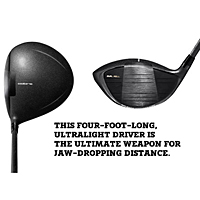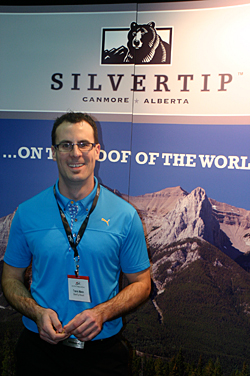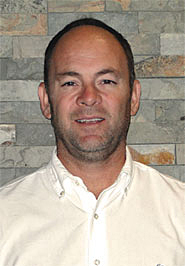Final Word: Golf’s Big Question – Is Going Farther Better Than Going Lower?
- Details
- Category: Final Word
- Published: 2015-12-30
by Gord Montgomery - Is “Go big or go home,” the best theory on the golf course?

In a quick study of the golf-related magazines scattered about in my office I came to a starling realization that at least nine of the 11 covers were about going deep off the tee.
Sure there were other cover stories about curing short game woes, and new equipment, but the overwhelming majority dealt with blasting the ball off the tee.
Image Caption : This Ad Is Somewhat Typical Of How Manufacturers Play To The Desire By Golfers To Hit It Long
Having heard a number of times that 90 per cent of golf is played within 100-yards of the green, I decided to do an unscientific survey among a few pros at the 2012 PGA of Alberta Golf Show in Edmonton to get their thoughts on what the most important part of the game is – driving, iron play or putting.
The questions I fired off to the pros I approached were simple: Where do you rank driving the ball in the importance of playing well?; Why do you feel the way you do?; and finally, Why do you think companies and media spend so much time focusing on the driver?
“I know it’s important to get the ball into play but to me it’s all about putting and 100 yards and in,” said Gary Christenson, the head pro at the Stony Plain Golf Course in being the first off the tee in this discussion.
“To me, driving would be second most important. The game’s easier when you’re on the fairway, 300-yards off the tee instead of 200.”
For Craig Kibblewhite, the director of golf at the Edson Golf & CC, hitting bombs places second behind the shortest shots in the game.

Image Caption : Brian Miller, The Head Pro At The New Trestle Creek Golf Course Suggests That The Immediate Feedback Players Get From Launch Monitors When Testing Drivers Makes An Impact and Helps Them See The Added Distance. But, He Adds, The Short Game Is Still The Key To The Game
“I’d say putting is the most important part of the game but at the same time, the game’s moved toward the fact the driver is important, trying to hit it as far as you can so you have a shorter iron into the green.”
Like Christensen, Kibblewhite stacks hitting the driver behind other parts of the game but it still sits near the top.
“I’d say second, then your wedge play, then obviously the rest of your game. The game’s become kind of a bomber’s game – the farther you can hit it the better you’ll probably score. It is important but then you have to be able to putt well, too.”
Brian Miller, the head pro at the new Trestle Creek GC west of Edmonton said any purist will tell you the short game is the most critical part of the game.
But, he added, launch monitors have changed the face of the game and tweaking the big dog in your bag so that everyone wants to have the newest driver they can afford.
“You get immediate feedback from those monitors,” he began. “By the time you add two weights, turn the head a little bit and add a little loft, you swing and hit that club 12 more yards on the monitor, and those are real numbers,” and that extra distance sells.
For Miller the driver, like the putter, is the most changed club in the bag.
“You have drivers out there now with 15 degrees of loft – that’ a 3-wood, but those are making it a little easier to hit fairways (off the tee). Seniors are getting some yardage back. The driver does play a big role,” but the short game is still the part where you score.

Image Caption : Travis Mann From Silvertip CG Says That You Don't Need To Go Deep To Score Well. Rather, Improving Your Short Game Will Pay Off More In The Long Run
Travis Mann, the head pro at the gorgeous Silvertip course in Canmore, joined the majority when faced with this question, saying to him the short game is more important than the long game.
“From a consumer standpoint you’re always inundated with the latest, greatest driver but at the end of the day the most important part of the golf game is from 100 yards in, without a doubt,” he stated.
“I find the game has less stress if you’re hitting the fairway off the tee but I don’t think you need to find that extra 10, 15 yards.
You pull back a few yards, hit the fairway all the time and if you practice your short game, that’s where your scores come down.”
Surprisingly, only one of the pros interviewed placed the big stick at the top of the pecking order.
Jeff Sveen, a Class A pro who now operates Play Golf Alberta, an online tee time booking site that has been profiled by Inside Golf, said in his opinion you’ve got to be able to get the ball out there off the tee to be able to score well.
“I think with my golf game and going through the ups and downs of golf, when you’re in position on the fairway, 300 yards off the tee, scoring is definitely easier,” he noted. “It’s very important.”
When asked about his feelings overriding the short game philosophy, he said that for pros in particular the area of 100 yards in is important but, “First of all, you’ve got to get off the tee.”
As for the emphasis placed on advertising drivers on TV and magazines devoting so much editorial copy to them, the reasons for that boil down to a few things the pros agreed – ego, ego and yes, ego.

Image Caption : Jeff Sveen Feels That Driving Distance Is Key To Scoring Well, The Only Pro Interviewed That Felt That Part Of The Game Was The Most Important Of All
““The mentality of golf now is long drive, right? ‘I want to be the longest I can,’ and ‘I want to out-drive my buddies,’ and things like that,” Kibblewhite said.
“I think it’s the golfer’s ego, when you can tell your buddies you hit it 320 down the middle, that has a lot to do with it,” Sveen suggested.
“The first club guys grab on the range is the driver, especially in the spring,” said Christensen. “And let’s face it, everyone like to hit a long drive. That makes you feel better than making a five-foot putt.”
When asked if the ongoing technology really does work, there’s mixed opinion on that.
“I’ve been playing the same driver for three years and when I take out a new driver I don’t think I hit it any farther, but everyone wants the latest and greatest technology,” said Kibblewhite.
“As for driver technology, obviously there is improvement from one year to the next, but how much? It’s hard to say.”
Miller sees some improvement as well but noted that not only are drivers tweaked on a regular basis but the golf ball as well, so that makes it hard to judge exactly what’s giving a guy those extra yards.
And about all that marketing hype and advertising dollars that go into new drivers? There’s a reason, the pros agree.
“Companies know the importance of drivers because that’s where they make their money,” Kibblewhite explained.
“Some people will use the same set of irons for 10 years but they buy a new driver every year. The companies know that’s the market where they can make the most money.”
So, when you come right down to it, it’s all about the big stick all the time for most players. A long curling 30-foot left-to-right putt for par is nice, sure, but not as glamorous as flying that fearsome water hazard with a 300-yard bomb off the tee in front of your buddies.
That, one pro said, is why guys do what guys do when they go hit balls.
"It’s an ego thing about how far you hit the ball,” Christenson said in closing. “But the game isn’t about how far you hit it - it’s about how many times you hit it.”
About the writer: Gord Montgomery is the sports editor of two weekly newspapers in the Edmonton area and is a member of the Golf Journalists Association of Canada. He has written for Inside Golf for the past four years with the majority of his coverage in north and central Alberta.
He can be reached at This email address is being protected from spambots. You need JavaScript enabled to view it..



